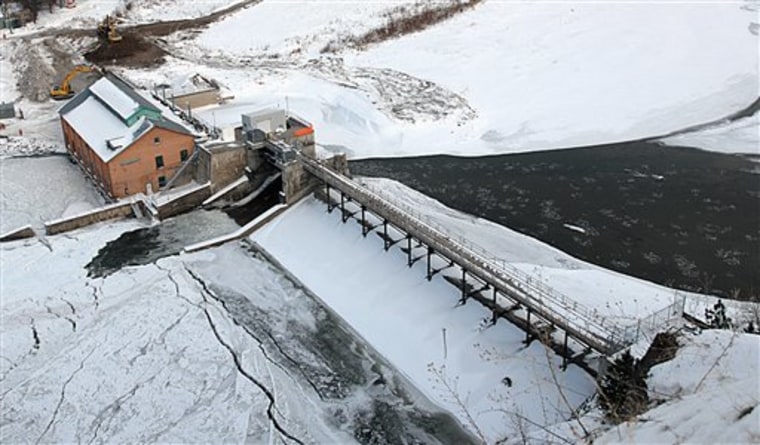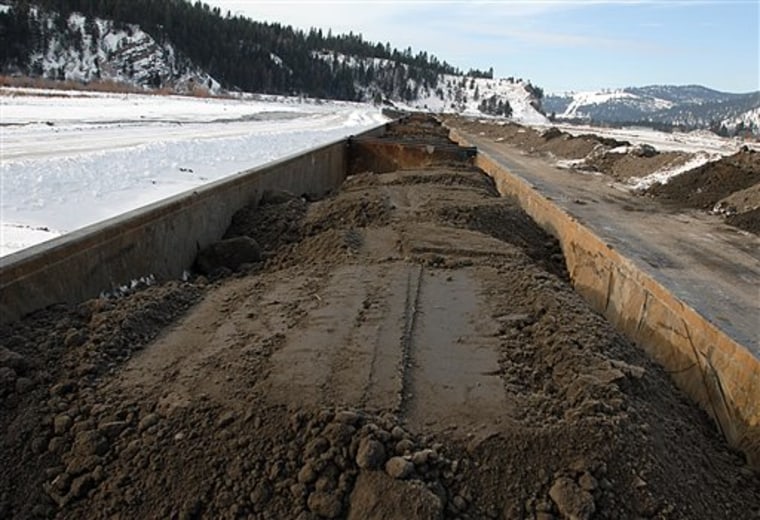Every evening, a 45-car train rumbles away from the Clark Fork River, loaded not with copper, gold or silver ore, but with the toxic legacy of more than a century of mining: tons of contaminated mud from behind an old dam.
Workers are removing 2.2 million cubic yards of the muck — and dismantling the 101-year-old Milltown Dam — in a breathtakingly scenic part of Montana trout-fishing country celebrated in Norman Maclean's novel "A River Runs Through It."
For decades, metals released into the river by mining and ore-processing in the Butte area collected downstream in the sediment behind the hydroelectric dam, where the toxins are now threatening fish and polluting drinking water in the ground below.
The dam is part of a big swath of southwestern Montana that has been designated the nation's largest Superfund cleanup site.
"Simply stated, 100 years ago they took hundreds of millions of dollars of gold and silver and copper out of the side of the mountain and they left us with a century of pollution," Gov. Brian Schweitzer said. "The money from the minerals went to Wall Street and the pollution went into Montana rivers."
Atlantic Richfield Co. assumed financial responsibility for the Milltown Dam site after a 1977 merger with Anaconda Co., the mining giant. ARCO is covering most of the estimated $120 million cost of the cleanup, with the state, the Environmental Protection Agency and a local utility paying the rest.
In the late 19th century, Butte was the world's copper king as America wired itself for the electric light, the telephone and other innovations. Nearly 22 billion pounds of copper were extracted from 1880 to 2005.
Lots of arsenic found in 1981
The contamination went undetected until 1981, when a county health official found high levels of arsenic in the water supply. Studying the problem, deciding on a fix, negotiating the funding and launching the work extended well into the 21st century.
The Milltown Dam, situated where the Clark Fork and Blackfoot rivers meet 88 miles northeast of Butte, is a concrete, rock and timber structure 28 feet high, with a spillway 210 feet across. It is being dismantled piece by piece with heavy-duty excavating equipment and jackhammers.

A train loaded with the mud has rolled out daily since October, bound for a disposal site 90 miles away. By the time the mud haul ends in 2009, an estimated 3.4 million tons will have been taken away, or enough to fill 679 Olympic swimming pools.
"What makes this really tricky is that we are removing a dam at the confluence of two rivers, and we are doing our best to minimize the impact on the fishery and the downstream river users," said the EPA's Diana Hammer. "This project, more than any other we are aware of, is spending a lot of money, time and effort to minimize the effect on the fishery and the downstream users."
For a few years, the Clark Fork will be detoured around the dam through a newly dug channel nearly a mile long. That will prevent the river from washing the toxic mud downstream as the dam comes down. Eventually, the river will be moved back to its natural channel.
Goal is for clean groundwater in decade
The EPA says the groundwater should be clean again within a decade. In the meantime, the area's residents are getting their water from a separate well system set up by state and federal officials in the 1980s.
Not only will the river water be cleaner, but with the removal of the dam, bull trout and other fish will be able to swim more freely.
"When the dam is removed and the entire Clark Fork is restored, we will once again have a free-flowing, blue-ribbon trout fishery," the governor said.
The overall Superfund site stretches some 120 miles from the Butte area almost to Missoula. It includes the Berkeley Pit, a former open-pit copper mine that now contains a toxic soup of arsenic, copper, cadmium, cobalt, iron and zinc.
So far, soil and water have been cleaned up in some parts of the Superfund area. Golfers now tee off at a Jack Nicklaus-designed course in Anaconda where a copper smelter used to belch pollution. And just last year, state officials announced the presence of trout in Silver Bow Creek, a Clark Fork tributary long considered dead.
As for the Blackfoot River, the trout stream made famous in Maclean's book, it has largely escaped contamination because there was not much mining upstream.
The Milltown Dam project is unpopular with some residents, because the calm, 535-acre reservoir behind the dam will disappear, along with its fishing and boating opportunities. They worry also that once the two rivers become free-flowing again, too many fishermen and boaters will flock to the area.
"We're removing the dam because special-interest groups had all these reasons — they said the dam was impairing the natural course of the river and the natural health of the river," said Jeff Patterson, who lives four miles upstream from Milltown. "But we're going to replace that with heavy human use that is going to be a greater impact on the river than the dam ever was."
Tim Furey lives about 300 yards from the reservoir and said he favors the work.
"If we get another major flood, the arsenic, the copper, the heavy metals are going to be washed downstream," Furey said. "Instead of one major Superfund site, we will have Superfund sites all along the Clark Fork River."
